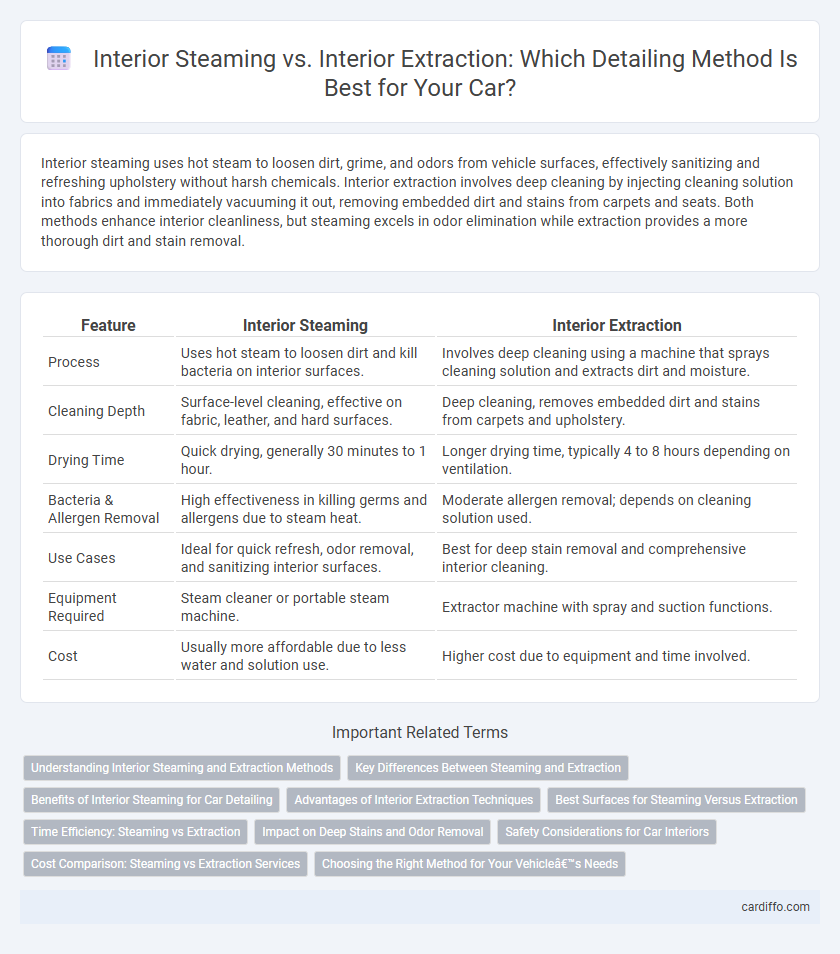Interior steaming uses hot steam to loosen dirt, grime, and odors from vehicle surfaces, effectively sanitizing and refreshing upholstery without harsh chemicals. Interior extraction involves deep cleaning by injecting cleaning solution into fabrics and immediately vacuuming it out, removing embedded dirt and stains from carpets and seats. Both methods enhance interior cleanliness, but steaming excels in odor elimination while extraction provides a more thorough dirt and stain removal.
Table of Comparison
| Feature | Interior Steaming | Interior Extraction |
|---|---|---|
| Process | Uses hot steam to loosen dirt and kill bacteria on interior surfaces. | Involves deep cleaning using a machine that sprays cleaning solution and extracts dirt and moisture. |
| Cleaning Depth | Surface-level cleaning, effective on fabric, leather, and hard surfaces. | Deep cleaning, removes embedded dirt and stains from carpets and upholstery. |
| Drying Time | Quick drying, generally 30 minutes to 1 hour. | Longer drying time, typically 4 to 8 hours depending on ventilation. |
| Bacteria & Allergen Removal | High effectiveness in killing germs and allergens due to steam heat. | Moderate allergen removal; depends on cleaning solution used. |
| Use Cases | Ideal for quick refresh, odor removal, and sanitizing interior surfaces. | Best for deep stain removal and comprehensive interior cleaning. |
| Equipment Required | Steam cleaner or portable steam machine. | Extractor machine with spray and suction functions. |
| Cost | Usually more affordable due to less water and solution use. | Higher cost due to equipment and time involved. |
Understanding Interior Steaming and Extraction Methods
Interior steaming uses high-temperature steam to loosen dirt, bacteria, and allergens embedded in car upholstery and carpets, providing a chemical-free deep clean. Interior extraction involves applying a cleaning solution followed by powerful suction to remove dirt, grime, and moisture, ensuring thorough stain and odor removal. Both methods target deep-seated contaminants but differ in technique and effectiveness based on the type of interior material and level of soiling.
Key Differences Between Steaming and Extraction
Interior steaming uses high-temperature vapor to loosen dirt and kill bacteria on surfaces, making it ideal for delicate materials and areas hard to reach. Interior extraction involves applying a cleaning solution followed by powerful suction to remove embedded dirt and moisture from fabric and carpets, providing a deep clean and faster drying time. The key differences lie in the cleaning method, moisture levels, and suitability for various interior materials.
Benefits of Interior Steaming for Car Detailing
Interior steaming in car detailing offers a deep clean by effectively killing bacteria, mold, and allergens without using harsh chemicals, making it ideal for eco-conscious vehicle owners. The high-temperature steam penetrates fabric and hard-to-reach areas, loosening dirt and grime while sanitizing surfaces, resulting in a fresher, healthier cabin environment. This method also dries quickly, reducing the risk of mold growth compared to traditional interior extraction techniques.
Advantages of Interior Extraction Techniques
Interior extraction techniques offer deeper cleaning by using powerful suction and specialized detergents to remove dirt, grime, and allergens embedded in upholstery and carpet fibers. This method effectively eliminates moisture and residue, reducing drying time and risk of mold growth compared to steaming. Enhanced extraction improves interior air quality, prolongs fabric life, and provides a more thorough, long-lasting clean in automotive detailing.
Best Surfaces for Steaming Versus Extraction
Interior steaming is best suited for delicate surfaces such as leather, fabric upholstery, and door panels, where gentle cleaning and sanitizing without excessive moisture are critical. Interior extraction excels on heavily soiled carpets and floor mats, as it uses powerful suction combined with cleaning solutions to remove deep-set dirt and stains effectively. Selecting the right method depends on the material type, with steaming preserving sensitive textures and extraction providing intensive cleaning for robust surfaces.
Time Efficiency: Steaming vs Extraction
Interior steaming offers significant time efficiency compared to interior extraction by quickly loosening dirt and grime without the need for drying time. Extraction involves prolonged vacuuming and drying phases, extending the overall cleaning duration. Steaming can reduce detailing time by up to 50%, making it ideal for quick, effective interior cleaning.
Impact on Deep Stains and Odor Removal
Interior steaming penetrates fabric fibers using high-temperature vapor, effectively loosening and lifting deep stains and eliminating odors by killing bacteria and allergens. Interior extraction involves applying a cleaning solution followed by powerful suction, which removes dirt and stains embedded deep within upholstery, while also extracting trapped odors from the car's interior surfaces. Both methods significantly enhance stain removal and odor elimination, but steaming provides a more hygienic and chemical-free approach.
Safety Considerations for Car Interiors
Interior steaming uses high-temperature vapor to sanitize and loosen dirt, minimizing chemical exposure and reducing the risk of allergen buildup in car interiors. Interior extraction relies on powerful suction combined with cleaning agents, which can introduce moisture risks and potentially damage delicate surfaces if not properly managed. Prioritizing safety involves choosing steaming for sensitive materials and ensuring thorough drying after extraction to prevent mold growth and preserve car interior integrity.
Cost Comparison: Steaming vs Extraction Services
Interior steaming typically costs less than interior extraction services due to lower labor and equipment expenses. Extraction involves more intensive cleaning with specialized machines that can drive prices higher, often ranging from $150 to $300 per session. Steaming offers a budget-friendly alternative, usually priced between $75 and $150, making it suitable for routine maintenance without compromising cleanliness.
Choosing the Right Method for Your Vehicle’s Needs
Interior steaming effectively sanitizes and loosens dirt from fabric and hard surfaces using high-temperature vapor, making it ideal for delicate materials and eco-friendly cleaning. Interior extraction employs powerful suction combined with cleaning solutions to deeply remove embedded dirt and stains from carpets and upholstery, providing thorough restoration for heavily soiled interiors. Selecting between steaming and extraction depends on your vehicle's fabric type, level of contamination, and desired depth of cleaning to ensure optimal interior care.
Interior Steaming vs Interior Extraction Infographic

 cardiffo.com
cardiffo.com